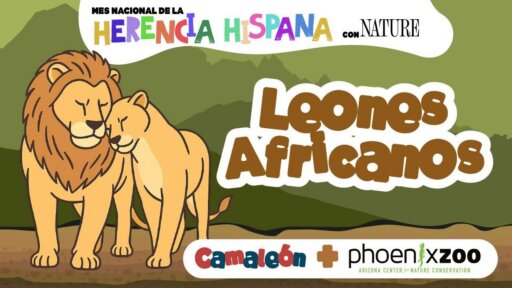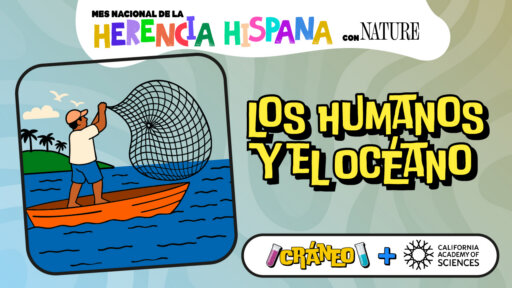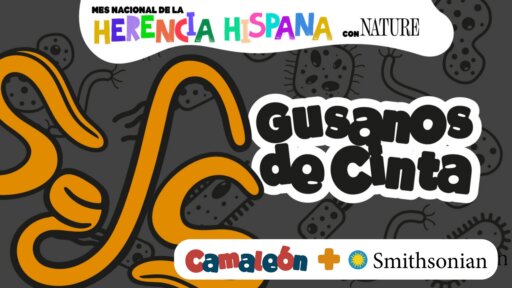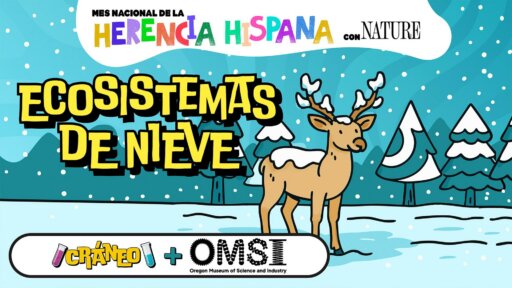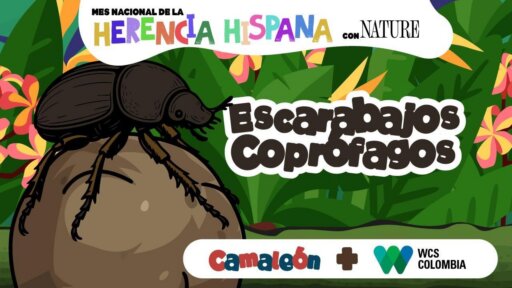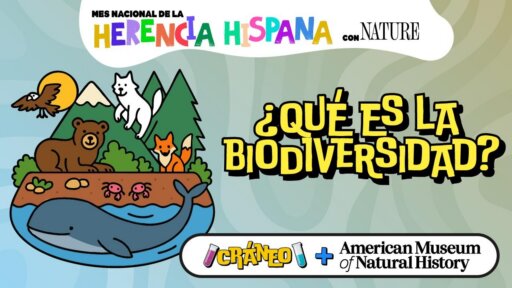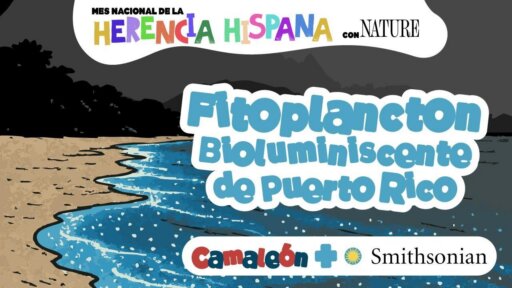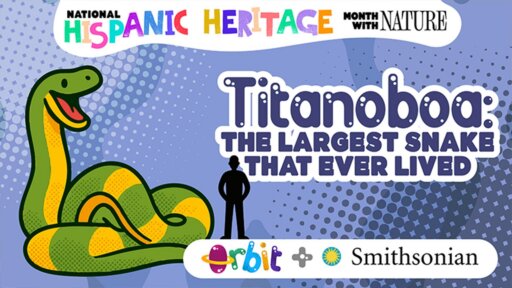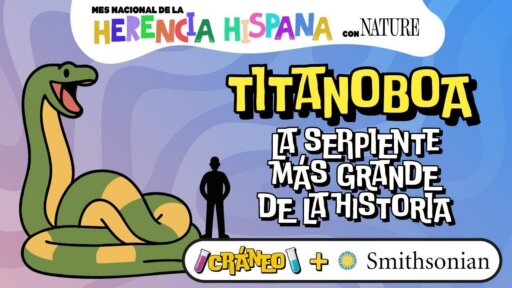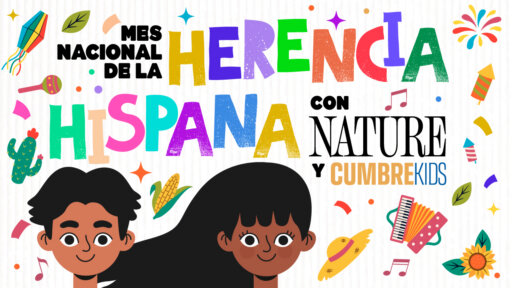TRANSCRIPT (EN)
00:00:00 Robert:
Hi there, Rob here.
00:00:02 Robert:
This episode is part of a bilingual children’s podcast series for National Hispanic Heritage Month, a collaboration between PBS Nature and Cumbre Kids.
00:00:10 Robert:
This series features scientists from leading museums, zoos, and aquariums across the United States, responding to questions submitted by children ages 3 to 10.
00:00:20 Robert:
These episodes appear on the podcasts Orbit: Science for Kids on the Move, Cráneos: Science for Curious Kids, and Camaleón: Animals for Curious Kids.
00:00:30 Robert:
They’re podcasts for families with children 3 to 10 years old, and can be found on YouTube, Spotify, Apple Podcasts, or wherever you listen to podcasts.
00:00:38 Robert:
Just a heads up — this episode is in Spanish.
00:00:41 Robert:
We hope you enjoy it.
00:00:46 Katherin:
Hi Cráneos, I’m about to make myself some hot chocolate.
00:00:55 Katherin:
Because I see gray clouds, and I think it’s going to rain. Yes, I definitely think it’s going to rain. I knew it was going to rain — what I don’t know is where the sound of thunder comes from and what lightning is made of.
00:01:17 Katherin:
Mhm, just like I sensed a storm was coming, I have a feeling a wave of curiosity is coming — Cráneo-style.
00:01:25 Children:
Hi Cráneos, my question is: how does lightning bounce off antennas that are made to attract lightning?
00:01:34 Children:
How do scientists study lightning?
00:01:38 Children:
Why does lightning produce light? How powerful is the electricity in a lightning bolt? Thanks, bye!
00:01:46 Katherin:
I knew it! Hey, I think I’m pretty good at predicting things. Anyway, today we’re going to have a slightly electric adventure because we’re going to learn about lightning. What is lightning, why does it make light and sound, and where does all that energy come from? For that, we’ll meet a very special guest who’s going to teach us all about it. Let’s greet her!
00:02:11 Dulce Enríquez:
Hi kids! My name is Dulce Enríquez, and I’m the Community Engagement Manager here at the Griffin Museum of Science and Industry. My job focuses on creating educational programs and events so that kids like you can learn about careers in the areas of science, technology, engineering, and mathematics.
00:02:33 Katherin:
What a beautiful job, Dulce — imagine that, Cráneos!
00:02:37 Katherin:
Creating activities so that other kids can discover how amazing science and technology are. And since today we’ll be talking about storms, lightning, and thunder, let’s start with the basics. Yes — because when I look at a storm, I can’t help but wonder: what is lightning, and how does it form in the sky?
00:03:00 Dulce Enríquez:
Of course! Lightning happens during thunderstorms.
00:03:04 Dulce Enríquez:
When water droplets in the clouds move around a lot and collide with each other, they generate electrical energy. The upper part of the cloud becomes positively charged, and the lower part negatively charged. These charges attract each other, like magnets. So when the energy becomes too strong, it’s released into the sky as a big spark — that’s lightning!
00:03:30 Katherin:
Wow, Dulce! So let’s recap.
00:03:34 Katherin:
Inside a cloud, there’s a whole party of water droplets moving and bumping into each other, and while that’s happening, they’re charging up as if they had invisible batteries. The top of the cloud gets a positive charge, and the bottom gets a negative charge — just like the poles of a magnet. But when those charges can’t take it anymore…
00:04:03 Katherin:
Zap! All that energy escapes as a giant spark — lightning! Imagine it as if the sky flipped a light switch, but on a massive scale — a really massive one.
00:04:22 Oliver:
Hi, my name is Oliver, I’m 5 years old, from Santiago, Chile. My question is: what’s the difference between lightning and thunder? Bye!
00:04:32 Dulce Enríquez:
That’s a great question! Many people talk about them as if they were the same thing, but lightning is a single zigzag flash that you see in the sky — a bolt of lightning. A “relámpago” (flash) is the entire phenomenon that can include many lightning bolts, and thunder is the loud sound that the lightning makes. That’s the noise you hear.
00:04:56 Katherin:
Very good, Dulce! So now we know that lightning is that giant spark crossing the sky, a relámpago is the whole light show we see during the storm, and thunder is the sound that makes us jump from fright! But that makes me think of Camila, Jimena, and Margaret’s question…
00:05:22 Jimena:
Hi, my name is Jimena Shera Burgos Raura. I’m 9 years old, and I’m from Mérida, Yucatán. My question is: why does thunder sound so loud?
00:05:32 Margaret:
Hi, I’m Margaret. I live in North Carolina, I’m 7 years old, and my question is: why does thunder make that huge sound when it hits the ground?
00:05:53 Camila:
Hi, I’m Camila. I’m 7 years old, and my question is: why do we see lightning first and then hear it afterward? Bye!
00:06:04 Katherin:
Well, my curious girls, this has to do with the speed of light and sound. Light travels super fast—so fast that it can go around the Earth seven times in one second.
00:06:19 Katherin:
Sound, on the other hand, is much slower. So when lightning strikes, the light reaches our eyes first, and the sound of the thunder takes a bit longer to reach our ears. And that super loud boom happens because the air around the lightning heats up so fast that it expands all at once.
00:06:48 Katherin:
It’s like the sky popping a giant balloon! That sudden expansion of air is what makes us hear that powerful noise.
00:07:01 Amelia:
Hi Cráneo, I’m Amelia Téllez, I’m 9 years old, I live in Bogotá, Colombia, and my question is: how powerful is the electricity in a lightning bolt? Thanks, bye!
00:07:12 Emma:
Hi, my name is Emma, I’m from El Salvador, I’m 5 years old, and my question is: what’s the maximum temperature of lightning? Thanks, bye Cráneo!
00:07:25 Dulce Enríquez:
Hi Amelia and Emma! Lightning can reach very high temperatures. In fact, it can heat the air it passes through up to 50,000 °F — that’s about five times hotter than the surface of the Sun!
00:07:45 Bruno:
Hi, my name is Bruno. I’m 3 years old. My question is: why does lightning produce light? A kiss for Katherin!
00:07:56 Katherin:
Oh, thank you, Bruno! Sending you a big, big hug back. Well, to answer your question — when lightning passes through the air, its energy is so incredibly strong that it heats the air to thousands of degrees.
00:08:11 Katherin:
In an instant, that heat makes the air glow brightly — just like when metal turns red or white when it gets really hot. So, as Dulce said a moment ago, the light from lightning is the result of all that enormous energy traveling through the sky, lighting up everything around it.
00:08:38 Katherin:
And before we move on to more questions, let’s sharpen our ears! Listen carefully, because this is the mystery sound. I’m going to let it play — listen one more time. Now, here are your options! Option A: it’s the sound of sandpaper. Option B:
00:09:07 Katherin:
It’s the sound of a pencil. Option C: it’s the sound of a brush. Got your answer? Keep it until the end! And before we go to more questions, I want to recommend our sister podcast, Buenas Noches, Cráneo. It’s the perfect podcast to listen to before taking a nap or going to bed at night. It has breathing and mindfulness exercises…
00:09:37 Katherin:
…that help everyone at home rest better. The link is in the description of this episode. Now, let’s keep going!
00:09:49 Augusto:
Hi clan, I’m Augusto Téllez, I’m 6 years old, I live in Bogotá, Colombia, and my question is: what were—what are the steps of Benjamin Franklin’s lightning experiment?
00:10:02 Augusto:
Thanks, bye!
00:10:03 Katherin:
Excellent question, Augusto! That was a very dangerous experiment that we should never try at home, okay? So, to answer it, how about we travel to the past? Ready, Cráneos? 3, 2, 1…
00:10:31 Katherin:
We’re in Philadelphia, in the year 1752. The sky is gray, the wind feels cold, and over there…
00:10:43 Katherin:
…is Benjamin Franklin, holding a kite in his hand.
00:10:46 Dulce Enríquez:
Benjamin Franklin actually didn’t discover electricity in that experiment.
00:10:51 Katherin:
That was already known!
00:10:53 Dulce Enríquez:
What he wanted to do was find out if lightning was the same as electricity.
00:10:58 Katherin:
Let’s go step by step to see how he did it. Step 1: Franklin built a kite with a lightweight wooden frame and covered it with a fabric that could resist the wind. Step 2: at the tip, he placed…
00:11:15 Dulce Enríquez:
…a metal wire and a key.
00:11:17 Katherin:
Exactly — that was to attract electrical charges. Step 3…
00:11:23 Dulce Enríquez:
He used two strings — one of them was wet.
00:11:26 Katherin:
That could conduct electricity.
00:11:29 Dulce Enríquez:
And the other one was dry, to keep him safe.
00:11:32 “Benjamin Franklin”:
Yes, yes! My kite is flying high! The key is sparking!
00:11:42 Dulce Enríquez:
When the rain soaked the wet string, the lightning caused sparks to jump from the key. That proved that lightning is electricity. It was a brave and clever experiment.
00:11:54 Katherin:
It was an incredibly risky experiment — but it changed forever the way we understand electricity. What a journey, Cráneos! Let’s return to the present!
00:12:11 Katherin:
All right, Cráneos, here we are back again. Did you notice how dangerous that experiment was? Franklin was standing right under a thunderstorm — he could have been struck by lightning! That’s why we should never, ever try anything like that. Today, we know that lightning contains an enormous amount of energy —
00:12:37 Katherin:
— so much that it can heat the air to thousands of degrees in an instant! So, if you see a thunderstorm, the best thing to do is enjoy it from a safe place. Although, I think Dulce can explain much better what we should and shouldn’t do during an electrical storm. Can you tell us, Dulce?
00:13:02 Dulce Enríquez:
Of course! There are three things I want to highlight.
First — find shelter. Go indoors at the first sign of thunder or lightning. Safe shelters include fully enclosed houses and buildings.
Second — avoid open spaces. Stay away from open areas, tall objects, and water. Don’t take shelter under trees or in tents.
00:13:32 Dulce Enríquez:
And third — it’s important to crouch down. If you’re caught outside with no shelter, crouch low to the ground with your feet together and your head down, avoiding contact with metal objects — that can help keep you safe.
00:13:49 Katherin:
Very good — safety first! Thank you, Dulce. Now let’s listen to León’s question, which also has to do with lightning.
00:14:00 León:
Hi, my name is León, I live in Uruguay, and my question is: why, how, how do lightning bolts bounce off antennas that are made for lightning? Bye!
00:14:18 Dulce Enríquez:
Of course, León! NASA has a network of antennas that detect and map lightning all across the country for data collection and safety purposes.
00:14:30 Dulce Enríquez:
The antennas don’t actually catch or reflect lightning — but they help keep us safe by precisely measuring where and when lightning strikes. That data is available in many apps. Lightning rods are safety devices that look like antennas, but what they actually do is safely guide the electrical energy from lightning.
00:14:53 Katherin:
Ah, I see! León, it seems like lightning bounces off the antennas…
00:15:00 Katherin:
…but that’s not really the case. What lightning rods — which sometimes look like antennas — actually do is give lightning a safe path to reach the ground without causing damage. When lightning strikes a building with lightning rods, the electricity travels through the metal straight into the ground, where it’s dispersed.
00:15:27 Katherin:
That way, it prevents the lightning from entering the house, damaging electrical appliances, or putting people in danger. In short, lightning rods don’t bounce lightning away — they guide it safely to protect us. And Cráneos, Dulce and I have a fun fact for you — did you know lightning isn’t unique to Earth?
00:15:55 Katherin:
There are also electrical storms on other planets in the solar system.
00:16:00 Dulce Enríquez:
That’s right! In fact, scientists have seen lightning on Jupiter and Saturn — they discovered this using special spacecraft — and they also believe it might occur on Venus and Uranus.
00:16:14 Katherin:
That sounds incredible, doesn’t it? And that connects us to the question from our friend Darío.
00:16:22 Darío:
Hi, I’m Darío, I’m 7 years old, I live in Mexico, and my question is: how do scientists study lightning? Thanks!
00:16:35 Dulce Enríquez:
Great question, Darío! Lightning is actually one of the most powerful and fascinating natural phenomena, so scientists use special tools to study it. They use ultra-high-speed cameras, rocket experiments,
00:16:53 Dulce Enríquez:
special aircraft, and even space satellites to safely observe and measure lightning and learn how it works. You can explore many of these devices in the Science Storms exhibit at the Griffin Museum of Science and Industry in Chicago — where you can even try measuring lightning yourself!
00:17:17 Katherin:
Wow, that’s amazing, Dulce! And Cráneos — the scientists who study lightning can be meteorologists, atmospheric physicists, or even electrical engineers. They combine science, technology, and curiosity to understand how electricity forms and travels through the atmosphere.
00:17:47 Katherin:
And of course, Darío — and all the Cráneos listening — you too could be part of this kind of research in the future! You just need to keep your curiosity alive, ask lots of questions, observe the sky, and keep learning about nature. Thank you, Dulce, for joining us in this episode.
00:18:11 Dulce Enríquez:
Of course! I’m so happy to have been here with you. I’m glad you’re all learning, and as we mentioned before, lightning — like many other things — is one of nature’s most fascinating scientific phenomena. If you keep exploring and asking questions, one day you could even become a scientist who specializes in lightning and helps protect people.
00:18:41 Dulce Enríquez:
And discover even more about the power of lightning!
00:18:48 Katherin:
What a beautiful message, Dulce. Thank you for joining us and helping us better understand the amazing world of lightning! And now, Cráneos, get ready — because one of my favorite parts of the show is coming up: the mystery sound! Let’s play it.
00:19:10 Katherin:
Listen one more time. Here are your options:
- the sound of sandpaper
- the sound of a pencil
or C. the sound of a brush. Got it?
It was a pencil — very good!
00:19:38 Katherin:
Now, Cráneos, let’s give some big birthday shout-outs!
Happy birthday to León Guajardo, who’s a huge robotics fan!
And also a big birthday greeting to Alberto Rodrigo and Federico José — they listen to us from Puerto Rico. We hope your week is full of curiosity and many scientific adventures. Happy birthday!
00:20:08 Katherin:
And with that, my dear Cráneos, we’ve reached the end of the episode. Cráneo is a production of Cumbre Kids. Robert Carpenter is our executive producer, Moisés Monsalve is our graphic artist, Jorge Cedillo is our illustrator, and I’m Katherin Aguilar, producer of this podcast. We’ll hear each other next week with a brand-new episode. Until then — keep your curiosity alive!

